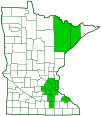Candy-striped spider
(Enoplognatha ovata)
Conservation • Description • Habitat • Biology • Distribution • Taxonomy
|
|
||||||||||||||
Description |
Candy-striped spider is an exotic, medium-sized, cobweb spider. It is native to Europe and was introduced into North America. In the United States its range has now spread from Maine and Virginia west to Minnesota and Illinois in the east, and from Washington and California east to Montana and Colorado in the west. In Minnesota it has been reported often in the Metro Region and in Duluth but is mostly absent from the remainder of the state. It is found in open fields, in forest understories, and in roadside ditches. It is seen on the underside of the leaves of brambles, low-growing vegetation, shrubs, and the lower branches of trees. It often appears in dense clumps, sometimes called colonies. Females are 3⁄16″ to ¼″ (4.3 to 6.8 mm) in length and have a ¼″ to ½″ (6 to 12 mm) legspan. Males are smaller, ⅛″ to 3⁄16″ (3.5 to 5.2 mm) in length. The front part of the body (cephalothorax) is flat and slightly longer than wide. The upper side (carapace) is pale yellowish-brown and shiny with few hairs. It has a more or less distinct longitudinal stripe in the middle and a thin black line on the lateral margins. There is a depression in the middle that is especially pronounced on the male. The underside is yellow to yellowish-brown with a dark stripe in the middle, a narrow black line on the lateral margins, and a black rear tip. There are eight eyes arranged in two parallel rows of four eyes each. The front (anterior) row is straight when viewed from the front and the rear (posterior) row is straight when viewed from above. On each side the lateral eyes are widely separated from the middle (median) eyes and are almost touching each other. All of the eyes are small. The anterior median eyes (AME) are dark, the rest of the eyes are pearly. The jaws (chelicerae) have one or two strong teeth on the front margin and one small tooth on the rear margin. The chelicerae on the male are much larger than on the female. The abdomen is pale yellow and rounded, almost spherical but slightly flattened in front. Candy-striped spider was previously described as three different species based on the color and markings on the abdomen. These are now known to be color variations (morphs) of a single polymorphous species. The former species epithets have survived as form names. The most common is form lineata, with four to seven pairs of black spots on the upper sides (dorsolateral) and no red stripes. Form redimita has two red dorsolateral stripes running the entire length of the abdomen. This is the feature that gives the species its common name. The least common is form ovata, with a single solid red dorsolateral band running the entire length of the abdomen. On the underside of the abdomen of all forms there is a prominent dark line with white borders. The legs are long and slender. The first pair of legs is the longest, the third pair is the shortest. There are no long hairs on the third segment (femur) and no thick spines on any segment. There is a dark ring at the end of the fifth segment (tibia) on the front pair of legs, but the legs are otherwise unmarked. There is a row of 6 to 10 slightly curved bristles (“comb”) on the last segment (tarsus) of each hind leg. This is the feature that gives the family one of its common names. There are three claws at the end of each tarsus, but these are not visible to the naked eye. |
Size |
Female Body Length: 3⁄16″ to ¼″ (4.3 to 6.8 mm) Male Body Length: ⅛″ to 3⁄16″ (3.5 to 5.2 mm) Legspan: ¼″ to ½″ (6 to 12 mm) |
Web |
A small, inconspicuous arrangement of tangled threads (cobweb) is constructed on the underside of a leaf. The edges of the leaf are often pulled down slightly and secured with silk threads, creating a retreat. The bent leaf is an indication of the presence of the web below. |
Similar Species |
Scarce candy-striped spider (Enoplognatha latimana) is morphologically indistinguishable from Enoplognatha ovata without a microscopic examination of the palps of the male or the genitalia of the female. It has also been introduced into the United States. However, aside from a single record in the southeast, its range is restricted to the West Coast. |
Habitat |
Open fields, forest understories, and roadside ditches |
Biology |
Season |
|
Behavior |
|
Life Cycle |
Eggs are enclosed in a round, bluish-white sac in summer and secured in a rolled leaf. The female guards the sac until the eggs hatch. Spiderlings in the second development stage (instar) disperse after several weeks. They overwinter in leaf liter. |
Food |
|
Distribution |
||
|
Sources |
|
| 11/30/2024 | ||
Occurrence |
||
|
||
Taxonomy |
|
Class |
|
Order |
|
Suborder |
Araneomorphae (Typical Spiders) |
Infraorder |
Entelegynae |
Superfamily |
Araneoidea (orbweavers and allies) |
Family |
|
Subfamily |
Pholcommatinae |
Genus |
Enoplognatha |
Subordinate Taxa |
|
|
|
Synonyms |
|
Aranea coronata Aranea lepida Aranea myopa Aranea purpurata Aranea redimita Aranea rubricata Aranea venusta Aranea vittata Araneus lineatus Araneus ovatus Araneus redimitus Phyllonethis lineata Steatoda redimita Theridion lineatum Theridion ovatum Theridion redimitum Theridion venustum |
|
Common Names |
|
candystripe spider candy-striped spider common candy-striped spider polymorphic long-jawed cobweaver |
|
Glossary
Carapace
The hard, upper (dorsal), shell-like covering (exoskeleton) of the body or at least the thorax of many arthropods and of turtles and tortoises. On crustaceans, it covers the cephalothorax. On spiders, the top of the cephalothorax made from a series of fused sclerites.
Cephalothorax
The front part of the body of various arthropods, composed of the head region and the thoracic area fused together. Eyes, legs, and antennae are attached to this part.
Chelicerae
The pair of stout mouthparts, corresponding to jaws, in arachnids and other arthropods in the subphylum Chelicerata.
Femur
On insects and arachnids, the third, largest, most robust segment of the leg, coming immediately before the tibia. On humans, the thigh bone.
Instar
The developmental stage of arthropods between each molt; in insects, the developmental stage of the larvae or nymph.
Tarsus
On insects, the last two to five subdivisions of the leg, attached to the tibia; the foot. On spiders, the last segment of the leg. Plural: tarsi.
Tibia
The fourth segment of an insect leg, after the femur and before the tarsus (foot). The fifth segment of a spider leg or palp. Plural: tibiae.
Visitor Photos |
||
Share your photo of this arachnid. |
||
This button not working for you? |
||
Kayla Langlee |
||
spider with egg sack |
||
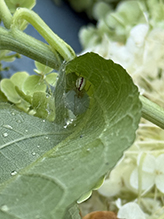 |
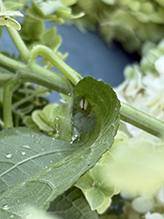 |
|
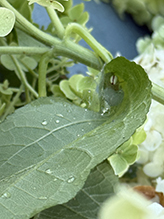 |
|
|
Alfredo Colon |
||
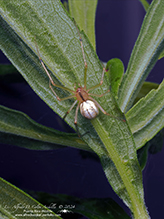 |
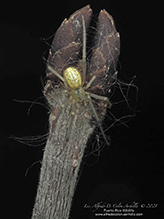 |
|
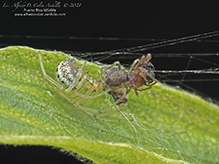 |
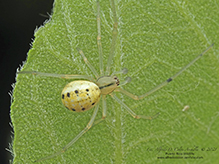 |
|
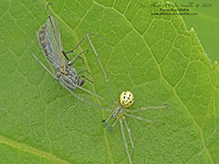 |
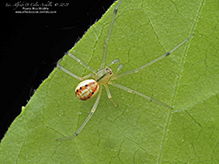 |
|
Babette Kis |
||
Enoplognatha ovata candy-striped spider |
||
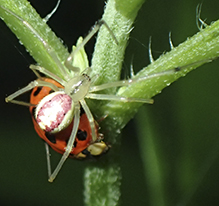 |
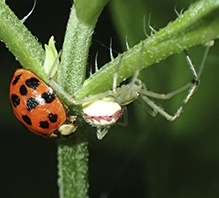 |
|
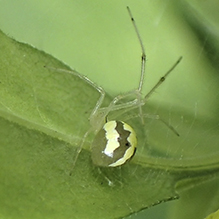 |
||
immature spider |
||
MinnesotaSeasons.com Photos |
||
|
||
|

Slideshows |
Title |

Visitor Videos |
||
Share your video of this arachnid. |
||
This button not working for you? |
||
|
Other Videos |
||
COBWEB SPIDER Enoplognatha ovata |
About
Oct 7, 2019 COBWEB SPIDER Enoplognatha ovata. Same family as Black Widow. McClaughery Springs FP, IL 7/4/2019. |
Comb-footed Spider - Enoplognatha ovata |
About
Aug 30, 2016 This species can only be reliably separated from Enoplognatha latimana by detailed examination with a microscope or good lens. |
Enoplognatha ovata |
About
Jul 3, 2014 The Candystripe Spider or Polymorphic Spider is a member of the Comb-footed Spider family ( Theridiidae ). It was introduced to North America from Europe. It builds its webs among vegetation. Vancouver, BC July2, 2014. Video by an Optex DIGIMAG 200 USB Microscope. |
Enoplognatha ovata |
About
May 28, 2009 Enoplognatha ovata Vs Aphid - Tug of war. |

Visitor Sightings |
||
Report a sighting of this arachnid. |
||
This button not working for you? |
||
Kayla Langlee |
Location: Duluth spider with egg sack |
 |
Alfredo Colon |
Location: Albany, NY |
 |
| Babette Kis 9/24/2022 |
Location: Barnes Prairie near hedgerow, Racine Co. WI |
 |
| Alfredo Colon 6/3/2021 |
Location: Woodbury, MN |
 |
| Alfredo Colon 6/1/2021 |
Location: Woodbury, MN |
 |
| Alfredo Colon 5/31/2021 |
Location: Woodbury, MN |
 |
| Imagoodbug 7/11/2020 |
Location: Milaca, MN (Mille Lacs County) Kept finding tiny ones that were harder to identify. Finally found (and smashed, sorry,) Mama (they're webbing up a storm in our garage and have to go.) Fairly sure they're Enoplognatha ovata |
|
| Babette Kis 6/27/2020 |
Location: Barnes Prairie near hedgerow, Racine Co. WI immature spider |
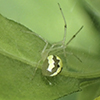 |
MinnesotaSeasons.com Sightings |
||
|

Created: 1/14/2022 Last Updated: © MinnesotaSeasons.com. All rights reserved. |
